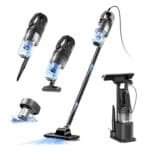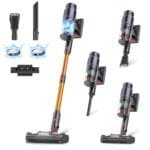Cyclonic separation is a technique used in many vacuum cleaners. It helps to remove dust and debris from the air.
In the world of vacuum cleaners, cyclonic separation stands out as a powerful technology. This method spins the air inside the vacuum, forcing dirt and dust to the sides. The clean air then exits through the top. This process not only boosts the vacuum’s efficiency but also ensures that filters stay cleaner for longer periods.
Understanding how cyclonic separation works can help you choose a better vacuum cleaner. It can also aid in maintaining your current vacuum for optimal performance. This blog post will break down the basics of cyclonic separation and explain its benefits.

Credit: www.reddit.com
Introduction To Cyclonic Separation
Cyclonic separation in vacuums helps remove dust and particles efficiently. It uses a spinning motion to separate debris from the air. This process ensures cleaner air and better performance.
### Introduction to Cyclonic SeparationHave you ever wondered how vacuums manage to keep your home free from dust and debris so efficiently? It’s all thanks to a fascinating process called cyclonic separation. This process helps vacuums maintain powerful suction while keeping the filters clean. Let’s dive into the details of this innovative technology.What Is Cyclonic Separation?
Cyclonic separation is a method used in vacuums to remove dust and particles from the air. This technique involves spinning the air at high speeds, creating a cyclone. The centrifugal force pushes heavier particles like dust and debris to the outer wall of the cyclone.These particles then fall into a collection bin, leaving clean air to be expelled. This process ensures that the filter doesn’t get clogged quickly, maintaining the vacuum’s efficiency.Imagine spinning a bucket of water around in a circle. The water moves to the edges due to the centrifugal force. Cyclonic separation works on the same principle but with air and dust.Historical Background
The idea of cyclonic separation isn’t new. It has been around since the late 19th century. Initially, it was used in industrial applications to remove dust from the air.In the 1980s, James Dyson revolutionized the vacuum cleaner industry with his invention. He adapted the industrial cyclonic separation technology for household vacuum cleaners. This innovation eliminated the need for vacuum bags.As a kid, I remember struggling with our old vacuum. It would lose suction quickly, and we had to change the bags often. Dyson’s invention made cleaning much easier and more efficient. It was a game-changer for households worldwide.Have you ever thought about the impact a simple innovation can have on daily chores? Cyclonic separation in vacuums is a perfect example. It’s a testament to how a clever idea can simplify tasks and improve our lives.Understanding the history and mechanics of cyclonic separation helps you appreciate the technology in your vacuum. Next time you clean your home, you’ll know the science working behind the scenes to keep your space dust-free.
Credit: www.amazon.com
Basic Principles
Cyclonic separation in vacuums involves spinning air to remove dust and debris. Dirt particles are thrown to the sides by centrifugal force. Clean air is left in the center, ready for reuse.
Cyclonic separation is a fascinating technology used in vacuum cleaners. It’s designed to improve efficiency and performance. This method helps vacuums remove dust and debris from the air using centrifugal force. Let’s explore the basic principles of cyclonic separation.How Cyclonic Separation Works
Cyclonic separation works by spinning air inside the vacuum cleaner. This spinning creates a cyclone effect. Dust and debris are thrown to the sides of the container due to centrifugal force.The clean air is then able to pass through the center of the cyclone. This process ensures that the dust is separated effectively. The result is cleaner air and a more efficient vacuum.Key Components
Cyclonic separation relies on several key components. The primary component is the cyclone chamber. This is where the spinning action takes place.Another vital component is the dust container. This collects the separated debris. Finally, the air filters help ensure that the air leaving the vacuum is clean.Together, these components work seamlessly. They create an efficient system for dust separation. This system improves the overall performance of the vacuum.Have you ever noticed how some vacuums don’t lose suction over time? This is thanks to cyclonic separation. It maintains a consistent airflow and suction power, providing a better cleaning experience.Do you think your vacuum could benefit from cyclonic separation technology? It might be worth considering next time you shop for a new vacuum.Types Of Cyclonic Separators
Cyclonic separators in vacuums come in different types, including single-cyclone and multi-cyclone designs. These devices efficiently remove dust and debris from the air. Understanding their variations helps in choosing the right vacuum for specific cleaning needs.
Understanding the different types of cyclonic separators can make all the difference in your vacuum’s performance. By knowing which type suits your needs, you can ensure cleaner air and more efficient dust removal. Let’s dive into two common types: Single-Cyclone Separators and Multi-Cyclone Separators.Single-cyclone Separators
Single-cyclone separators are the simpler of the two. These separators use a single, large cyclone to filter dust and debris from the air.I remember the first time I used a vacuum with a single-cyclone separator. The dust collection was impressive. The large cyclone spins air at high speed, pushing dust to the edges and down into the bin.This type is generally easier to clean. However, it might not be as effective at filtering finer particles. If you have a lot of fine dust, you might notice some escaping back into the air.Multi-cyclone Separators
Multi-cyclone separators take things up a notch. Instead of one large cyclone, they use multiple smaller cyclones. This design enhances the vacuum’s ability to capture fine dust particles.From my experience, multi-cyclone vacuums keep the air noticeably cleaner. The multiple cyclones create a more powerful centrifugal force, trapping even the tiniest particles.These separators require less frequent filter changes. However, they can be more complex to clean. The multiple cyclones need careful maintenance to keep working efficiently.Have you ever wondered why your vacuum sometimes leaves a fine dust trail? The type of cyclonic separator could be the answer. Choosing the right one can significantly impact your cleaning routine.Next time you are in the market for a vacuum, consider what type of cyclonic separator it uses. It could make your cleaning efforts more effective and your home a healthier place.
Credit: www.shophacks.com
Cyclonic Separation In Vacuums
Understanding the mechanics behind vacuum cleaners can be fascinating. One of the essential technologies in modern vacuums is cyclonic separation. This technique is key to efficient cleaning and maintaining suction power.
Application In Household Vacuums
Cyclonic separation is used in many household vacuums. It works by spinning dust and debris out of the air. This spinning action creates a cyclone that separates dirt from the air. The dirt collects in a bin, while the clean air is expelled.
This method helps vacuums maintain consistent suction. Traditional vacuums can lose suction as the bag fills. With cyclonic separation, you don’t have this problem. The vacuum stays powerful even when the bin is full.
Industrial Uses
Industries also use cyclonic separation for various applications. Factories and workshops use it to keep air clean. It helps remove particles from the air, improving air quality. This is crucial in environments with lots of dust or fumes.
Industrial vacuums with cyclonic separation can handle larger debris. They are built to endure tough conditions and continuous use. This makes them reliable tools in heavy-duty cleaning tasks.
Benefits Of Cyclonic Separation
Cyclonic separation is a powerful technology in modern vacuums. It offers several key advantages that enhance cleaning efficiency, reduce maintenance, and extend the lifespan of the vacuum. This section explores these benefits in detail.
Efficiency
Vacuum cleaners with cyclonic separation are highly efficient. They can trap dust and debris quickly. This means cleaner air and surfaces. The cyclonic action creates a strong airflow. It spins particles out of the air. This process ensures that even tiny particles are captured. Improved efficiency leads to better cleaning results. Homes and offices stay cleaner for longer.
Maintenance And Longevity
Vacuum maintenance is crucial. Cyclonic separation reduces the need for frequent maintenance. The technology prevents clogging. Filters stay cleaner for longer periods. Users spend less time and money on upkeep. A well-maintained vacuum lasts longer. The motor and other parts face less wear and tear. This extends the lifespan of the vacuum. Investing in a vacuum with cyclonic separation is wise. It means fewer replacements and repairs.
Challenges And Limitations
Understanding the challenges and limitations of cyclonic separation in vacuums can help users make informed decisions. This section explores some common issues faced with this technology. It aims to provide a clear picture of what to expect.
Particle Size Limitations
Cyclonic separation works well for larger particles. Tiny particles often escape the cyclone’s grasp. This can reduce the overall effectiveness. Small dust particles may pass through and remain in the air. This is a significant limitation for those with allergies. Ensuring a clean environment might need additional filters.
Energy Consumption
Cyclonic separation can consume a lot of energy. The process requires strong airflow. This can lead to higher power usage. It can increase electricity costs. Users should consider this when choosing a vacuum. Energy efficiency is an important factor. Balancing power and performance can be challenging.
Innovations In Cyclonic Technology
The world of vacuum cleaners has seen many changes. Cyclonic separation is one of the most exciting ones. This technology improves the efficiency of vacuums. It removes dirt and dust more effectively. Let’s explore the recent advances and future prospects in cyclonic technology.
Recent Advances
Recent advances in cyclonic technology focus on better dust separation. Engineers have developed multi-cyclone systems. These systems use several smaller cyclones. They increase the efficiency of dust removal. This reduces the amount of dust in the air.
Another advancement is in the design of the cyclones. Modern vacuums have smoother surfaces inside the cyclones. This helps the dust move more easily. It also reduces clogging and maintenance needs. Some vacuums now use transparent cyclones. This allows users to see the dust collection process.
Smart sensors are a new addition. They monitor the performance of the vacuum. These sensors can adjust the suction power automatically. This ensures optimal performance on different surfaces. Some vacuums also have self-cleaning features. These features remove dust from the cyclones without user intervention.
Future Prospects
The future of cyclonic technology looks bright. Researchers are working on even more efficient cyclones. These will use less energy and be quieter. They will also have a longer lifespan.
Integration with smart home systems is another future prospect. Vacuums could be controlled through voice commands. They could also sync with other smart devices. This would create a seamless cleaning experience.
Nanotechnology might play a role in future vacuums. Tiny structures could improve dust separation. They could also make the cyclones more durable. This would lead to even less maintenance and better performance.
Environmental concerns are driving innovation too. Future cyclonic vacuums will use eco-friendly materials. They will also consume less power. This will make them more sustainable choices for households.
Choosing The Right Cyclonic Vacuum
Cyclonic separation in vacuums uses centrifugal force to filter dust and debris. This method ensures consistent suction power, reducing the need for frequent filter changes. Choosing the right cyclonic vacuum can enhance cleaning efficiency.
Choosing the right cyclonic vacuum can make a world of difference in your cleaning routine. It’s not just about picking any vacuum off the shelf; it’s about finding one that suits your specific needs. Whether you have pets, kids, or just a lot of dust, there’s a perfect cyclonic vacuum for you.###Factors To Consider
First, think about your home’s layout. Do you have a lot of carpet or mostly hard floors? Some cyclonic vacuums excel on carpets, while others are better suited for hardwood.Next, consider the size of the vacuum. If you have a small living space, a compact model might be more practical. On the other hand, larger homes might benefit from a more powerful, albeit bulkier, vacuum.Don’t forget about maintenance. Check how easy it is to clean the filters and empty the dust bin. A vacuum that’s hard to maintain will end up being more of a hassle than a help.Look for extra features like attachments for pet hair or crevice tools for tight spaces. These can make your cleaning tasks much easier and more efficient.###Top Brands And Models
Dyson is a popular choice for cyclonic vacuums. Models like the Dyson V11 have powerful suction and a range of attachments. They are a bit pricey but worth the investment for their efficiency and durability.Shark also offers great options, like the Shark Navigator. It’s versatile and comes with a range of useful attachments. Plus, it’s generally more affordable than Dyson.If you’re on a budget, the Bissell CleanView is a fantastic choice. It offers solid performance without breaking the bank. Plus, it’s lightweight and easy to maneuver.Remember, the best vacuum for you depends on your specific needs and preferences. Take the time to evaluate what you really need. This small effort upfront can lead to a much cleaner home and a happier you.Maintenance Tips
Understanding how to maintain your vacuum with cyclonic separation can extend its life. Proper maintenance also ensures the vacuum works at its best. Here are some essential tips for keeping your vacuum in top shape.
Regular Cleaning
Regular cleaning is vital for the efficiency of your vacuum. Empty the dust container after each use. This prevents clogging and maintains suction power. Clean the filter every month. Remove it and rinse with water. Allow it to dry completely before reinstalling. Check the brush roll for tangled hair and debris. Use scissors to cut away any buildup.
Common Troubleshooting
Even with regular maintenance, issues can arise. If your vacuum loses suction, check for blockages. Inspect the hose and nozzle for obstructions. Clean them if needed. If the vacuum overheats, check the filter. A clogged filter can cause overheating. Clean or replace it. Strange noises often indicate a problem. Check for trapped debris in the brush roll or motor area. Remove any blockages to resolve the noise.
Frequently Asked Questions
How Does Cyclonic Separation Work?
Cyclonic separation uses centrifugal force to remove particles from air or liquids. The mixture enters a cylindrical chamber. As it spins, heavier particles move to the walls and are collected. Clean air or liquid exits through the center. This method efficiently separates contaminants.
What Does Cyclonic Mean In A Vacuum Cleaner?
Cyclonic in a vacuum cleaner means it uses cyclonic separation to remove dirt and debris from the air. This process improves suction and efficiency.
What Is The Principle Of Cyclonic Separation?
Cyclonic separation uses centrifugal force to remove particles from air or liquid. The mixture spins rapidly inside a cylindrical container. Particles are forced to the outer edge and collected, while the clean air or liquid exits from the center. This method effectively separates dust and debris.
Which Is Better Single Cyclonic Or Multi Cyclone Vacuum Cleaner?
Multi-cyclone vacuum cleaners offer better suction and efficiency. They maintain performance longer and require less maintenance.
Conclusion
Cyclonic separation in vacuums offers many benefits. It ensures cleaner air. It also increases the vacuum’s efficiency. This technology extends the life of your vacuum. Say goodbye to clogged filters. Maintenance becomes easier and less frequent. Understanding this concept helps you make better choices.
Choose a vacuum with cyclonic separation. Enjoy a cleaner home with less effort. Keep your environment healthy and dust-free. Happy cleaning!





